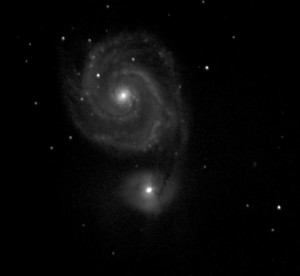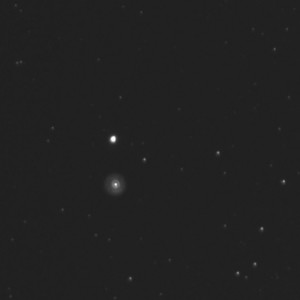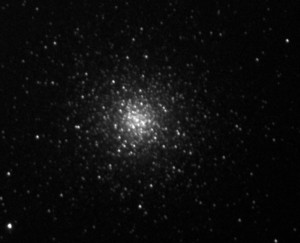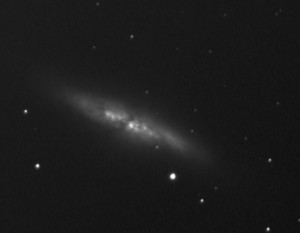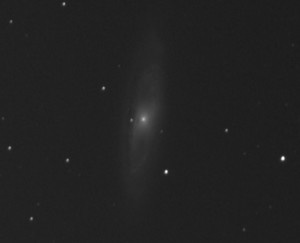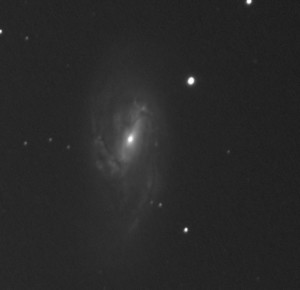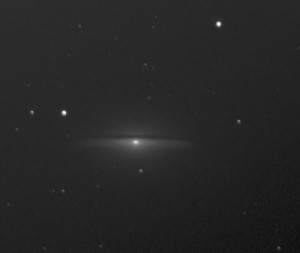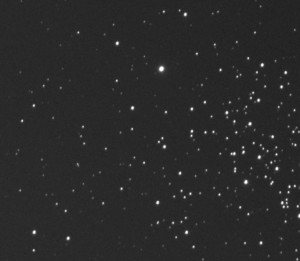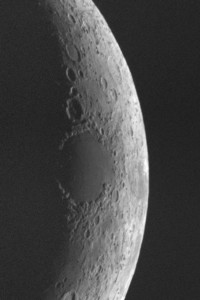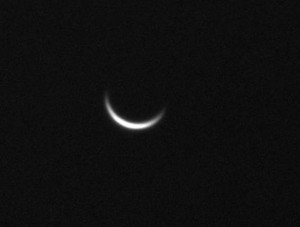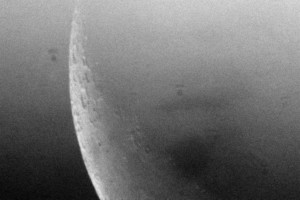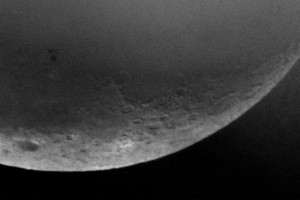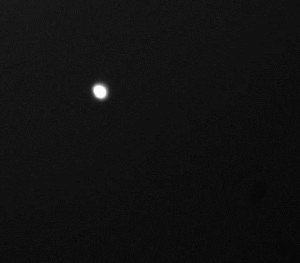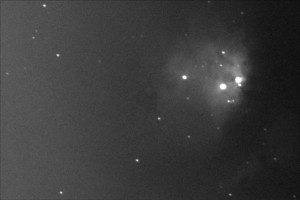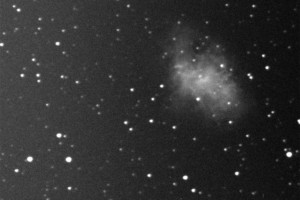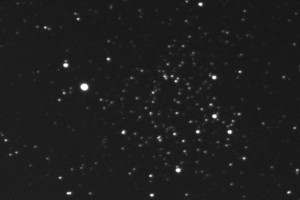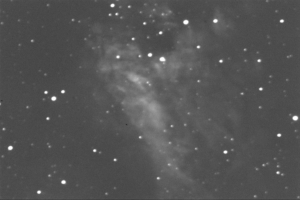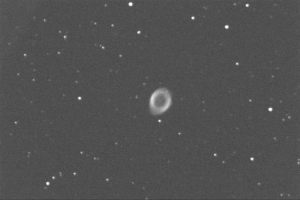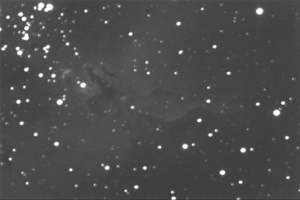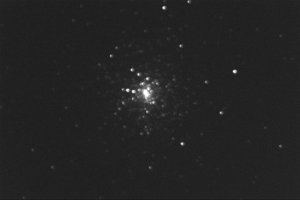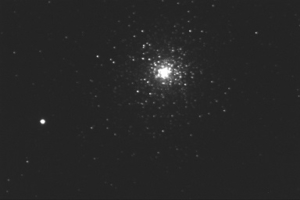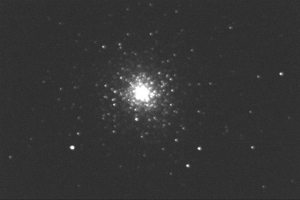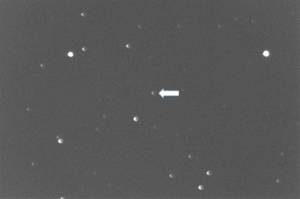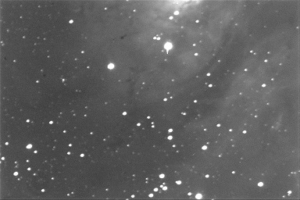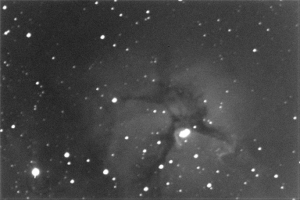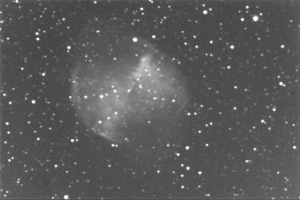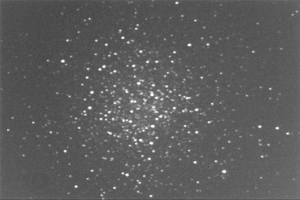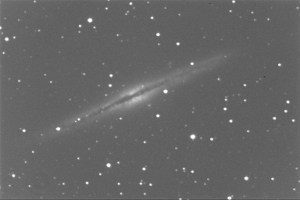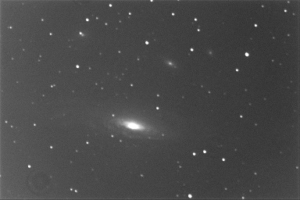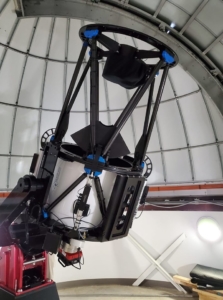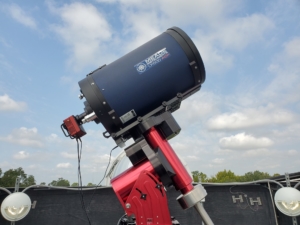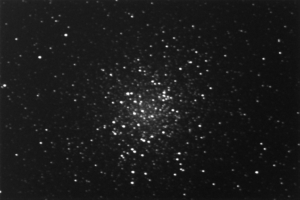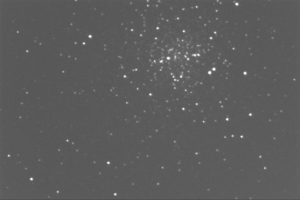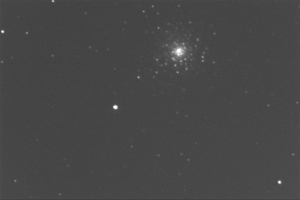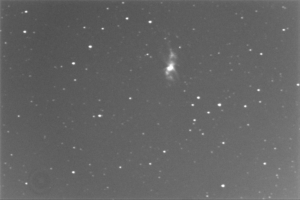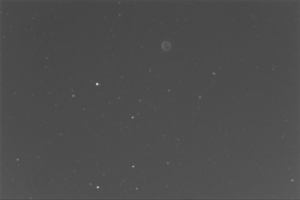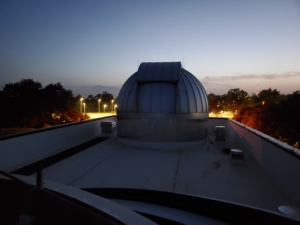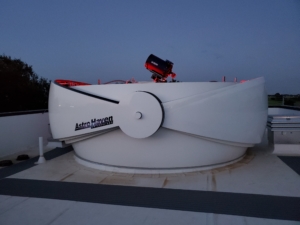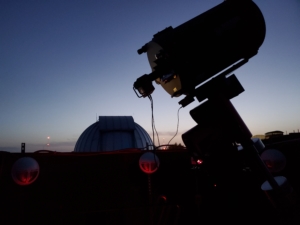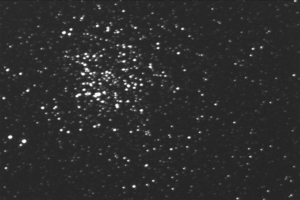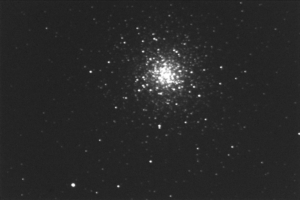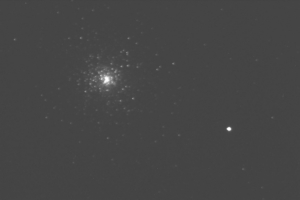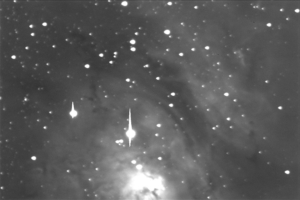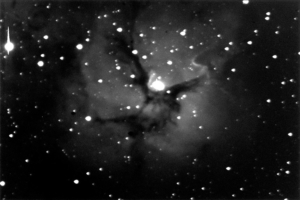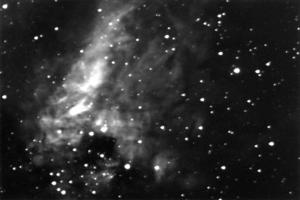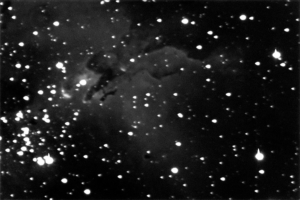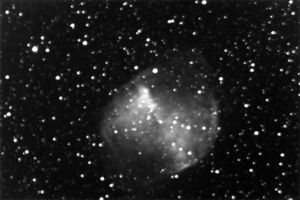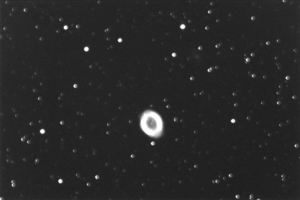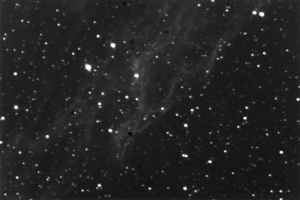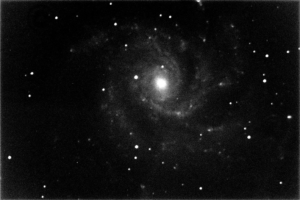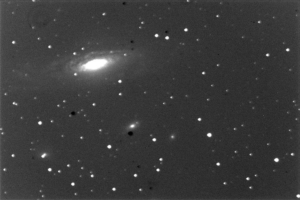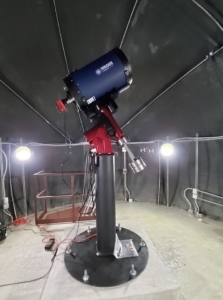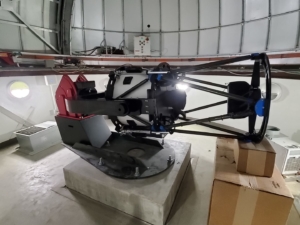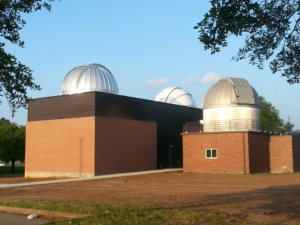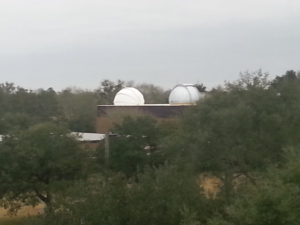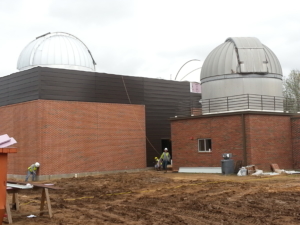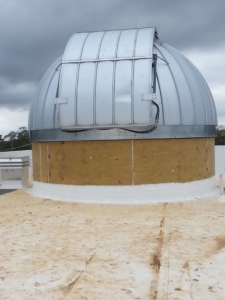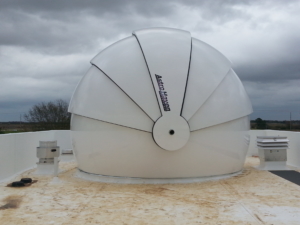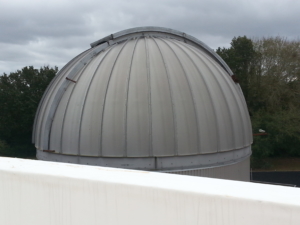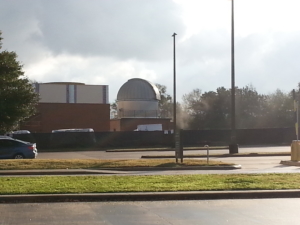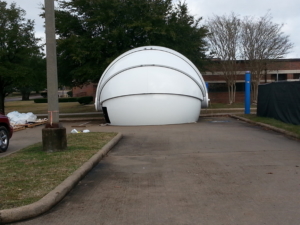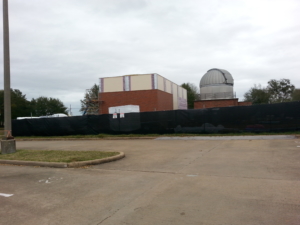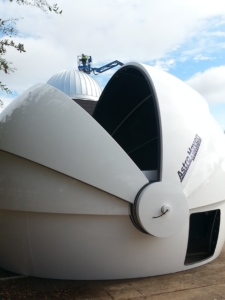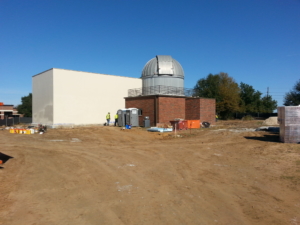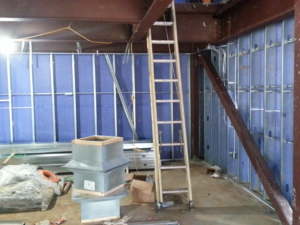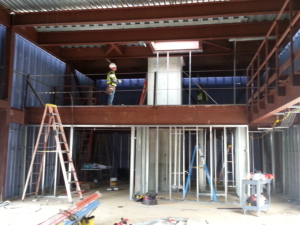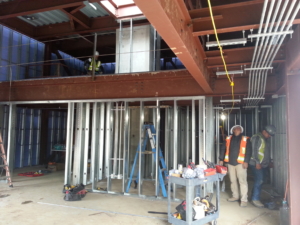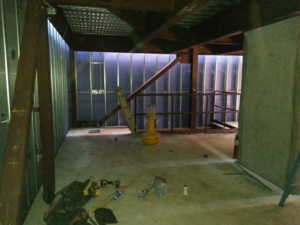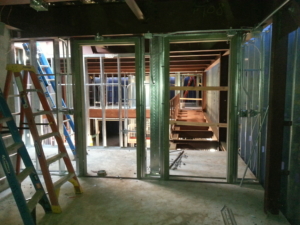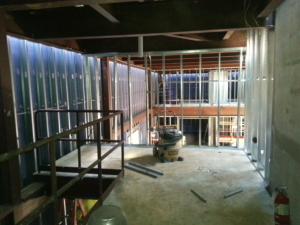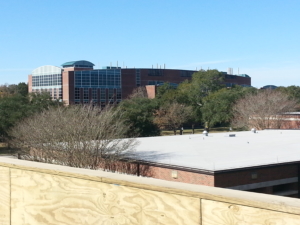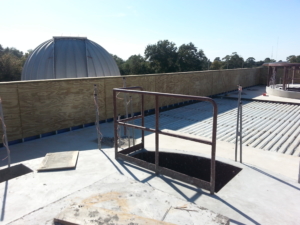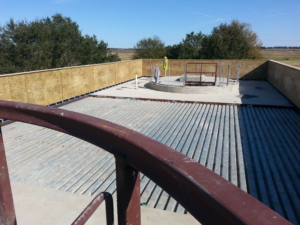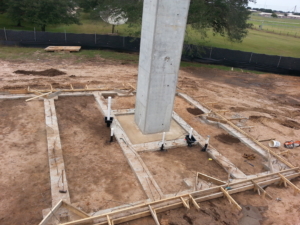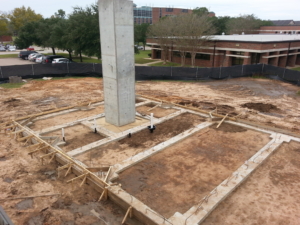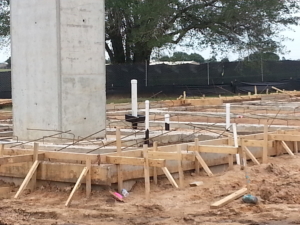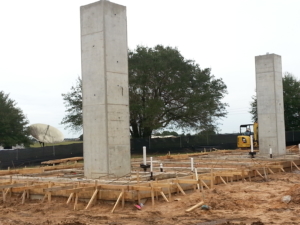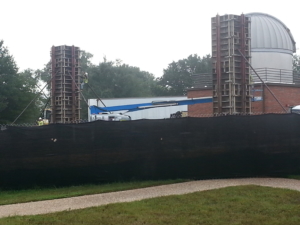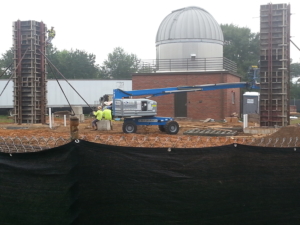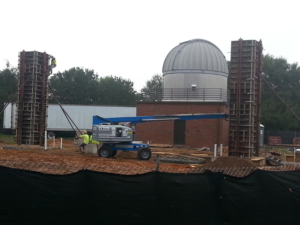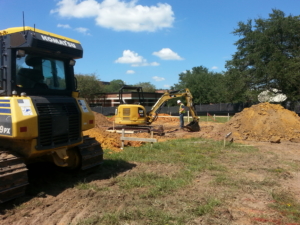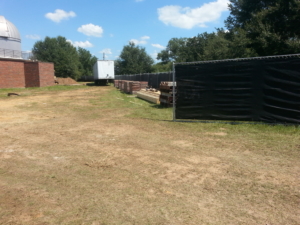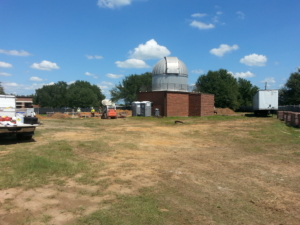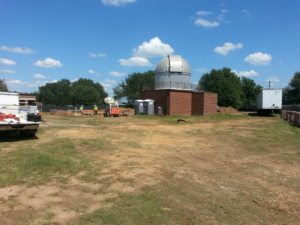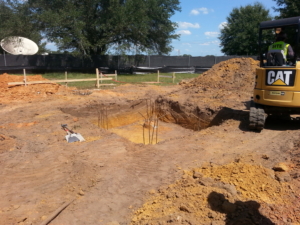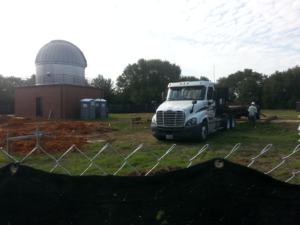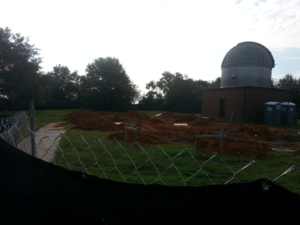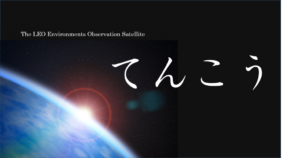May 2021 Update
Note: All images on this website © 2018-2021 by Brian Cudnik and Prairie View A&M Physics. All rights reserved.
With unexpected cooperation from the weather for the date of the total lunar eclipse on the morning of May 26, I used a University-issued telescope, the 11-inch f/10 Celestron, along with a personal cell phone camera in professional mode to obtain the following images of the ingress partial phases of the eclipse. The Moon was just above the horizon during the 15 minute totality, and was hidden by daylight, fog, and some low clouds. The following images were made afocally through the 41 mm eyepiece of the telescope at the times indicated.
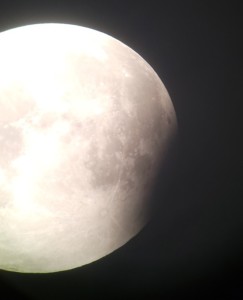
9:48:27 UT |
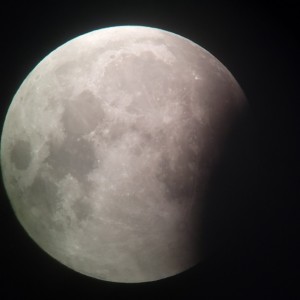
9:55:01 UT |
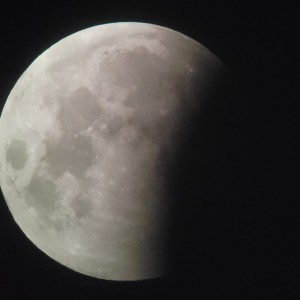
10:02:47 UT |
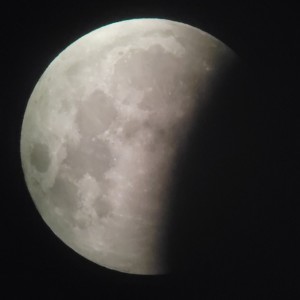
10:07:44 UT |
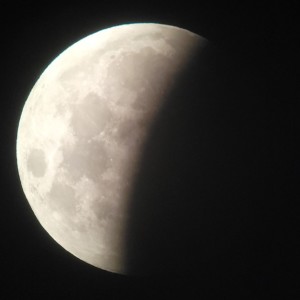
10:17:44 UT |
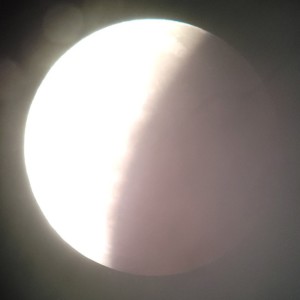
10:23:39 UT |
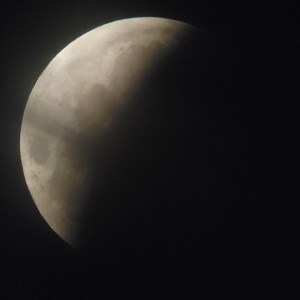
10:28:23 UT |
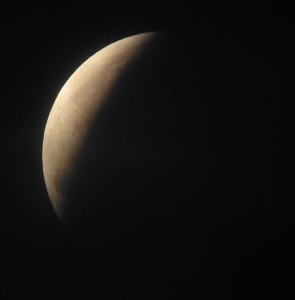
10:44:03 UT |
* * * * * * * * * * * *
After a rather tumultuous Spring Semester, the University is preparing to welcome back its staff to work on campus full time June 1. This will bring with it the opportunity to do more work with the Observatory. So far this year, the work has been limited to the solar observation program but I was able to get a few hours of nighttime imaging in as we slowly develop our capabilities. The images below are a sample of some monochrome images that were obtained from the East Dome on the evening of May 6th. These images were mainly galaxies with a few other objects thrown in, including part of an open cluster, M67, that is used for measuring how dim one’s system can image.
Each of the images was obtained with the Meade 16-inch and SBIG ST 8300 camera, unfiltered. Exposures were made in subs of 30 seconds each, ranging from 2.5 minutes for the globular, cluster, and planetary, up to 10 minutes total for the galaxies. The images were processed and stacked with MaxIM DL.
The first is M 51, the Whirlpool Galaxy and its companion NGC 5194. The larger is a grand design spiral galaxy 76,000 light years across. Both galaxies lie an estimated 31 million light years distant
This is part of open cluster M67, which is a useful image for judging how faint the imaging system can go. M67 is 2700 light years away and has more than 500 stars.
We are also watching solar active regions as they form and evolve. The sequence below shows a series of images of a small region (arrowed in the first image) west of AR 12822 as it lofted a dark loop skyward. Images like these help us to see such activity as well as any flare activity that takes place. Each of the below images in the sequence was taken on 14 May 2021 at the times indicated. The source region of the loop became a single spot early that afternoon and remained single, not receiving an NOAA number for the duration of its visibility-about two days before rotating out of view.
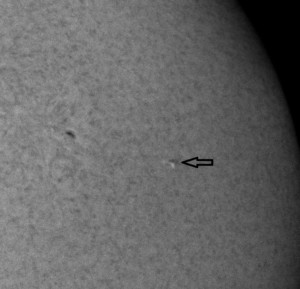
19:44:35 UT |
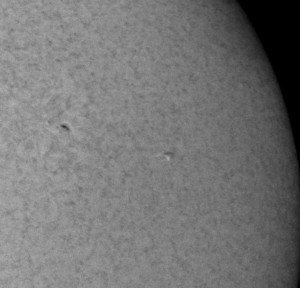
19:46:46 UT |
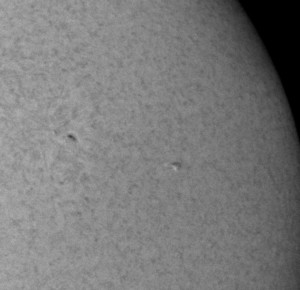
19:48:04 UT |
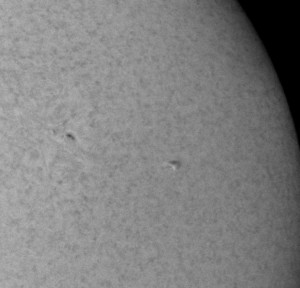
19:49:27 UT |
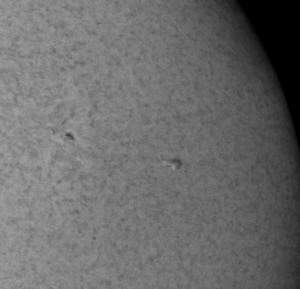
19:51:15 |
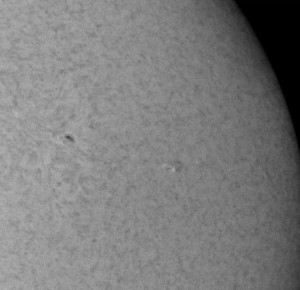
19:53:26 UT |
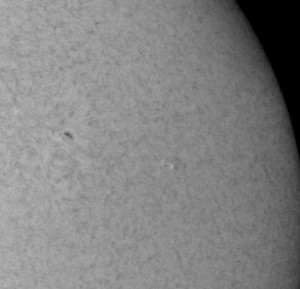
19:54:21 UT |
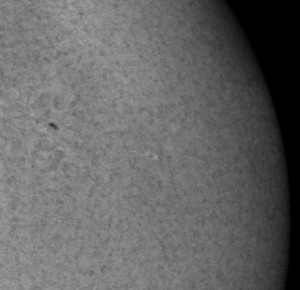
19:56:30 UT |
As we move into the summer months we plan to work on bringing the CDK 24-inch telescope on line as well as beginning to take color images of deep sky objects. The solar observation program will continue throughout the summer and beyond.
December 2020 Update
As the year begins to wind down, we wrap up the first year of routine solar observations since they were ended over five years ago. The solar observing program was initiated and modified over the year as we became familiar with the capabilities and limitations of our equipment, schedule, and weather. A program rather similar to one carried out for so many years at the original Prairie View Solar Observatory (now the South Dome) is underway: focus is on a region of the Sun’s disk, primarily sunspot groups and other solar features, visible with Hydrogen-alpha emission light. This year was also the first year that the Sun had displayed significant activity for an extended time, so we were able to initiate our active region (sunspot group) activity and evolution monitoring. Moe information on the details of the current setup, which is making use of the equipment in the East Dome, can be found on the recent solar observations site. Unlike the Vacuum Solar Telescope, which involved a rather small circular aperture of 7 arcminutes; we are able to take in more of the sun with the current system’s 14.5’x9.6′ field of view.
Work has again come to a halt at the observatory due to a significant resurgence of coronavirus and a return to remote working protocols. A curfew in the city of Prairie View issued earlier this year limited nighttime activity in the East Dome. However, for the first time in nearly six months, we have taken some experimental images of the Moon and planets. At the time of the images, Jupiter and Saturn were still too far apart in the sky to be contained in a single field of view. Samples appear below.
The images were made with the 4.875-inch diameter orange energy rejection filter in place, along with the 0.9 neutral density filter to cut back on glare. The Moon image above was one of a set of mosaic components collected around 23:00 UT, 17 December 2020, about 30 minutes prior to sunset. Each of the planet images below were made within a few minutes of 23:10 UT, same date, about 20 minutes prior to sunset (which is why Saturn appear so faint). The images were 0.1 second exposures and were dark- and bias-frame subtracted and corrected with sky flats. The planets appear so small and bland because no Barlow lens was used to magnify the images, nor were filters used to mitigate the seeing effects. Each frame below is a 5’x5′ section of image, oriented north up, west right, and enlarged by 25% in the processing. The Moon image above is a full frame image, 14.5′ tall by 9.6′ wide and is softened a bit by sky glow.
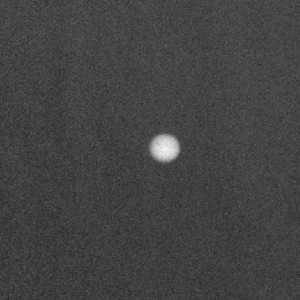
Jupiter |
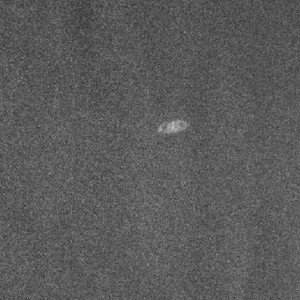
Saturn |
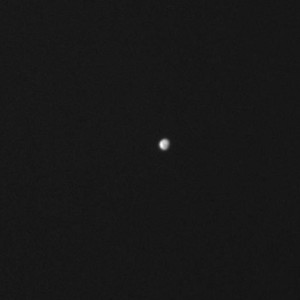
Mars (Syrtis Major visible) |
In the future we plan to incorporate video technology to lunar, solar, and planetary imaging to significantly improve the quality of the images and allow for the beginning of a program to monitor Jupiter for meteors. The view is currently a wider field to incorporate a larger region of Sun for solar observation (hence the small planetary image size). We will need to identify and purchase a video camera for this purpose, along with a 2x or 3x Barlow lens to enlarge the image. Short video segments of each object will be collected, then processed by identifying and removing individual frames that capture the sharpest views. The website, https://www.thelondonastronomer.com/it-is-rocket-science/2018/6/7/a-quick-guide-to-planetary-imaging, is one of many which provide guidance for creating such images and these will be our references going forward.
More immediately, we will upgrade the camera to the ST-8300 and continue routine observations. Eventually we will include a color filter with various color and narrow-band filters for expanded observational capability. This should be completed by the end of Spring 2021, depending on various cirumstances.
The South Dome remains dormant as of this writing, but in the New Year, I plan to try something new with the telescope. I plan to use the Calcium-K filter with this scope. The challenge is to making the system light-tight in the section containing the collimating lenses, i.e. “the box” below the Vacuum Solar Telescope tube. Once this is accomplished and a suitable camera is found that is able to work with the very faint violet light of Calcium-K, routine monitoring of active regions in Ca-K will being and be carried out along with the current H-alpha observing program. The Ca-K observations will cover a smaller area on the Sun, a circular aperture some 7′ in diameter. Unlike the East Dome setup, which can image two or three (or more) active regions at once; the Solar Dome setup will only be able to take in one region at a time.
The CDK 24 remains in stasis but that will soon be changing. Starting in January 2021, as circumstances allow, we will begin putting the scope “through its paces” to evaluate its current functioning and focus ability. We will likely follow a pattern similar to what we did earlier with the Meade 16: start with only the camera (in the case of the 24 inch, an SBIG STX-16803 CCD camera) and find and maintain focus. Next we will take a lot of images of various parts of the night sky to assemble a pointing model for the system that runs the telescope. Once this is built, then we will take a bunch of unfiltered test images of various celestial objects such as nebulae, clusters, comets and other nighttime objects. After that, a filter wheel will be incorporated (it is already assembled with LGRB and narrowband H-alpha, SII and OIII filters) and more images will be taken. We plan to have this setup fully operational by the end of summer 2021, taking into account the current situation with the pandemic and all.
July 2020 Update
Work has again come to a halt at the observatory due to a significant resurgence of coronavirus and a return to remote working protocols. A plan has been put in place to address the issues of the CDK 24 (the 24-inch PlaneWave scope in the West Dome) and these will be implemented as soon as we are able. Work will continue as we are able to going into the latter part of the month.
June 2020 Update
Work came to a halt in mid-March due to the onset of the coronavirus pandemic. As of this writing in mid-June we are slowly working to bring things back up to speed. The solar observation program resumed in mid-June, but the Sun continues to be very quiet and not sporting any significant features in the Hydrogen-alpha band to observe. We continue to do daily high-resolution H-alpha mosaics once or twice per day. The East Dome setup continues to operate very well, with only a minor concern about the south part of the clamshell dome, which stalled during the last observation run March 24. This seems to be resolved for the moment, but we do not need to use this part of the dome this time of year to access the Sun. The west dome remains “in stasis”, but we will soon be collecting resources and expertise to address the issues currently holding up progress with the telescope. Work on this scope is expected to resume early next month or late this month sometime.
The Solar Dome also remains on hold as issues with the vacuum pump prevent observations with this historic vacuum solar telescope (VST). Once personnel return for the fall term and are able to assist with this and other aspects of the telescope. we will resume work on the VST.
The next step is to assemble the filter wheel and check the compatibility of this wheel and newer SBIG camera with the current system in the East Dome. Once this is verified, we can begin color imaging of celestial objects, starting with the bright objects that require shorter exposure times. We also will be working to control the telescope from the mezzanine level remotely as well as connecting the visitor center monitor to the dome level computer to enable display of observations and activities there. All this is planned to take place next month.
Two crescents are shown with this update: the crescent Venus taken early afternoon local time on 16 June 2020, and the crescent Moon, pulled out of the hazy sky, as it gets low in the west during the early-afternoon hours. One can get a sense of the haziness of the skies and how faded the waning crescent Moon was in the daytime sky. I also tried to spot Mercury, which was also a waning crescent at this time; however, the bright hazy sky and the planet glowing at 2nd magnitude (even with it high in the East at the time of the attempt) prevented its capture as an image.
I will continue to post updates as progress is made on the Prairie View Observatory complex.
January 2020 Update
A new semester has begun and work continues on the observatory. For the West Dome, we are in the process of obtaining the needed parts to enable the camera to be mounted on the 24-inch within its focal plane. Once these arrive and are installed, then we can obtain focus and begin the needed imaging of starfields all over the sky, which will be used to build a pointing model. This model is essentially the controlling computer’s “road map” of the sky which will enable the telescope to go to and accurately point at selected objects. The computer that controls the telescope will also control the camera, the filter wheel, the focus, and the dome; this is a program called “TheSkyX” and more work needs to be done to optimize the coordination between the telescope and the dome (to line them up better).
The over-the-aperture energy rejection filter has been received and installed on the 16-inch in the East dome, and is being used, along with our existing H-alpha filter, to make solar observations. We are planning to use the 16 inch for solar observations in H-alpha for the foreseeable future. I plan to install the Calcium-K filter on the Vacuum Solar Telescope and make some imaging attempts with this, once the Sun presents a sizable active region that can be imaged. We may then use these telescopes in parallel to obtain regional images of the Sun in H-alpha and Calcium-K.
The 16-inch is also being used for lunar and nighttime imaging. Some examples of images obtained thus far this month and last month appear below. These will be the last of the images presented here; we will maintain a separate page for “Latest Observations” starting later this month.
Each Moon image was obtained in the late afternoon of January 7, 2020; the moon was a waxing gibbous at this time. The Energy Rejection filter was in place over the aperture of the 16-inch. Normally used with solar imaging, this filter helped by darkened the sky and increasing the contrast. A neutral density filter that transmits 10% of the incoming light was used to reduce the intensity to a manageable level. Exposure time for each image was 0.1 second.
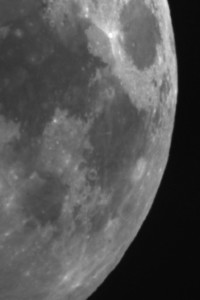 The west limb of the Moon is imaged here showing Mare Crisium (dark patch top right corner) and Mare Fecunditatis (just right of center). The bright spot on the right edge of Fecunditatis is the crater Lagrenus. The west limb of the Moon is imaged here showing Mare Crisium (dark patch top right corner) and Mare Fecunditatis (just right of center). The bright spot on the right edge of Fecunditatis is the crater Lagrenus. |
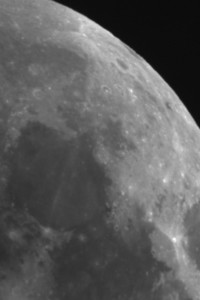 The northwest part of the Moon, which shows Mare Tranquilitatis below center. The northwest part of the Moon, which shows Mare Tranquilitatis below center.
|
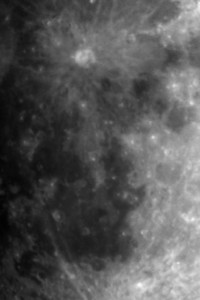 The center of the moon’s disk is featured here, which displays Mare Cognitum. The bright spot above and slightly left of center is the large crater Copernicus; its ejecta field appears as lighter gray radiating all around within the mare. The center of the moon’s disk is featured here, which displays Mare Cognitum. The bright spot above and slightly left of center is the large crater Copernicus; its ejecta field appears as lighter gray radiating all around within the mare. |
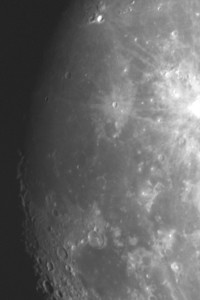 The eastern part of the Moon’s disk displays part of Mare Imbrium (top right corner), the bright crater Aristarchus (top center) and Oceanus Procellarum. Also seen is Mare Humurum (bottom center) and the crater Kepler (just above center, tiny bright spot in a larger light gray area), The eastern part of the Moon’s disk displays part of Mare Imbrium (top right corner), the bright crater Aristarchus (top center) and Oceanus Procellarum. Also seen is Mare Humurum (bottom center) and the crater Kepler (just above center, tiny bright spot in a larger light gray area), |
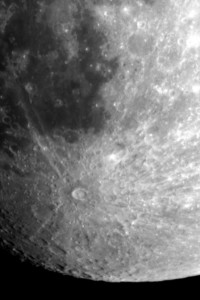 Southern region of the Moon highlighting the rugged highlands, dominated by the crater Tycho (below and left of center with lines [ejecta] radiating from it). Mare Nubium hangs like a cloud in the upper left corner of the image. Southern region of the Moon highlighting the rugged highlands, dominated by the crater Tycho (below and left of center with lines [ejecta] radiating from it). Mare Nubium hangs like a cloud in the upper left corner of the image. |
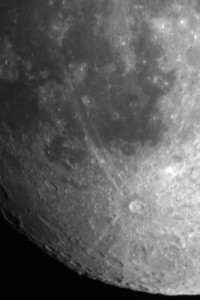 Same as previous but with the focus shifted eastward a bit. This shows the complex of “seas” Mare Cognitum, Mare Humorum, Mare Nubium, and Mare Insularum. A map showing the exact locations of maria and major craters can be found at this website. Same as previous but with the focus shifted eastward a bit. This shows the complex of “seas” Mare Cognitum, Mare Humorum, Mare Nubium, and Mare Insularum. A map showing the exact locations of maria and major craters can be found at this website. |
Visit Site Except for the first image of Venus, taken on January 7, each of the below images were obtained on the evening of December 18th with the Meade 16 and the unfiltered SBIG STT 1603 camera. Exposures range from 30 seconds for the open cluster to 60 seconds for the nebulae.
December 2019 Update
As of this writing we are preparing for some construction in our main building (O’Banion) and preparing for the holiday break. We were not able to take any observations due to a combination of weather and commitments but we look to make one more observing run before the actual holiday break begins in one week. The observing run has been with the 16-inch Meade in the East dome. In addition, an over-the-aperture energy rejection filter has been procured and received and this will be used, along with our existing H-alpha filter, to attempt solar observations on the 16 inch. This may lead to our using the 16 inch as our solar telescope until the main Vacuum Solar Telescope is ready for use. In this case, the vacuum pump is not working properly so we are not able to evacuate the solar telescope. Once this is repaired, and the optics re-aligned, then the 35-cm Vacuum Solar Telescope will be returned to service.
The Planewave 24-inch telescope remains in a holding pattern as we await the replacement spacer to enable our cameras to rest in or near the focal plane of the instrument. In addition, the dome and scope control are not synchronized and this may be an issue with the dome itself. We will be contacting all relevant parties to get this issue settled, then, along with the needed part for the 24-inch camera system, we will be able to finally take the many needed observations of star fields to calibrate the pointing of the telescope and get it to function properly once again. The Planewave 24-inch will likely not be worked with further until after the first of the new year.
Final touches on the construction of the facilities are being made as the project gets ready to be concluded (as far as building and facilities are concerned).
October 2019 Updates
Each of the following images was obtained on the evening of October 23rd.
We continue to put the system in the east dome through the paces as we focus on obtaining useful calibration images and improving the focus. One objective for the evening was to image the fields of view for about a dozen known variable stars. This was not successful due to field rotation issues and pointing issues (the pointing has become a bit less accurate). We will continue to work on these issues in future observing sessions and begin implementing some of the planned observing projects.
The image below is the most distant object imaged to date. It is the distant quasar PG 1604+706 (arrowed) and is the first of the set of variables scheduled for observation. The object lies some 9.9 billion light years away.
——————————————————————————————–
The West Dome Planewave 24-inch telescope is briefly in a holding pattern as we await the arrival of a needed part to move the camera to the focal plane. Once this arrives and is installed, we will be able to make a series of observations to build what is called a “pointing model” which, in the process, precisely polar aligns the telescope. We also need to improve the synchronization of dome to telescope so that the dome is positioned such that the telescope is looking through the center of the opening at all times. Once the model is built in the computer, the telescope will be able to slew (move quickly) to target and that target should appear at or near the center of the image frame each time. Like we have done with the East Dome, we will start with an unfiltered monochrome camera to capture the first images to ensure focus and pointing and light collecting ability. After a few nights of this type of observing we will switch in the “imaging train” which is a setup consisting of a camera, filter wheel with filters, and guiding camera and possibly an adaptive optics utility. Once these are in place we can set up a feed (most likely done over the internet) from the computer controlling the telescope to a monitor in the Visitor Center, which will display what the astronomers are looking at. We will eventually move the control to the second (Mezzanine) level and commence with routine observations.
Observations continue to be collected from the East Dome Meade 16-inch. These are unfiltered monochrome images of various deep-sky objects that were collected on the evening of October 9, with a bright, waxing Gibbous Moon in the sky. I (Brian Cudnik) plan to use these in my section of Physical Science lecture and lab later in the semester when we cover astronomy. The first set of images are three examples of nebulae or huge clouds of gas and dust. The first two are emission nebulae and the last is an example of a planetary nebula. The first two are located in Sagittarius, and the last is in Vulpecula. The information about the subject of each image appears below the image.
The next two images are open star clusters, which are identified below each frame. Both are found among the dense star clouds of the Sagittarius Milky Way.
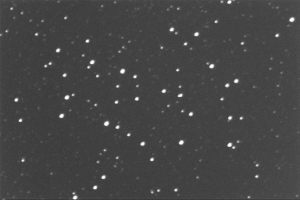
M 25 |
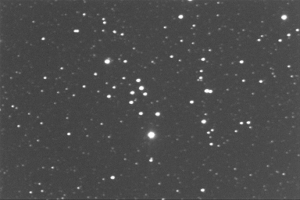
M 23 |
Globular star clusters come in a variety of sizes. Many were recorded this night and show an array of density and structure. The first is Messier 55 in Sagittarius, one of the brightest such clusters visible in Sagittarius. The 6 additional images were obtained of various globular clusters; the identities of each are written below the image.
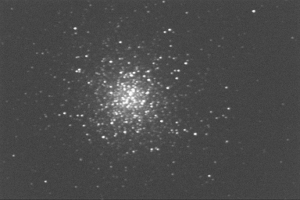
M 13 the Great Hercules Cluster |
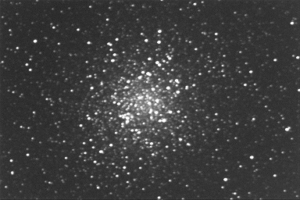
M 22 the great Sagittarius Cluster |
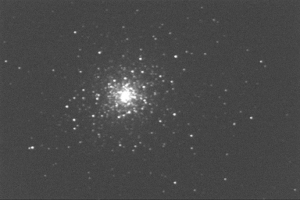
M 92 in Hercules |
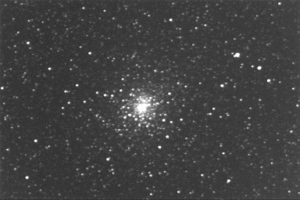
M 28 in Sagittarius |
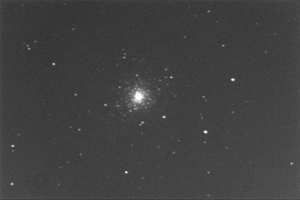
M 75 in Sagittarius |
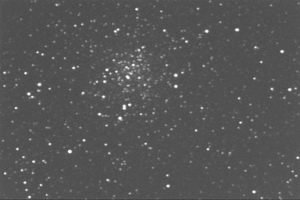
M 71 in Vulpecula |
Similar to the plans for the West Dome, the East Dome will eventually be controlled from the Mezzanine level as we remotely access the dome level computer with another computer in another room. Also like the West Dome, we will connect the East Monitor in the Visitor’s Center to the dome computer so that visitors can see what the astronomers are observing at any given time.
Two galaxies are shown below: NGC 891, taken last week; and NGC 7331 along with s few of its companions.
Unfortunately for the Solar Dome the vacuum pump is not working properly. The good news here is that the solution is likely as simple as adding oil. We just moved into a period of unfavorable observing weather here in Southeast Texas, so we may be limited as far as the access to the Sun. We will add oil to the vacuum pump next week, then once the vacuum pump is able to pump as much air out of the telescope as possible, we will connect the camera currently in the East Dome to the Solar Telescope, and collect images via a laptop connected to the camera. Images produced during this time should give insight into the condition of the optics, any of which will be addressed soon. The Sun is at solar minimum meaning dark high-contrast sunspot groups are very rare; these are useful to “latch onto” to get a good focus and good evaluation of optical quality. This is a work in progress.
We did try out the Takahashi 5.1 inch refractor with the solar wedge in place. Visually the mages were stunning with a small transient sunspot visible near the limb of the Sun. Granulations were seen as well. The next step is to find the power supply and a good videocamera to take video images of the Sun. The video will be run through a special program to sort out the best frames and stack these to obtain the final image. This is how planetary observation will be done here also.
September 2019 Updates
With the 16-inch now achieving minimal imaging capability the focus (pun intended) now turned to the Planewave 24-inch telescope. This scope needed to be balanced and polar aligned to enable it to reach image acquisition capability. In mid-September, Matt from Planewave spent several days working on balancing the telescope and organizing the cables (“cable management”) so that they are restrained yet not impeding the motion of the scope. He worked on programming the telescope, dome, focus, and camera to work as a system to obtain observations. Ultimately we wish to automate this system so that it will work autonomously. Due to a problem with the focal plane location versus the length of extender provided, fine-tuning the rough polar alignment as well as constructing a pointing / mount model was not possible at this time. The next step in the process will be to obtain the right extender so that the camera system can reach focus with this telescope.
We are awaiting some solar activity to provide targets to “tune” the vacuum solar telescope on. A nice hedgerow prominence had been on display for several days- check it out at https://www.spaceweather.com/, scroll down to story entitled “Huge Solar Prominence and read the story therein (if the story cannot be found, go back to the top of the page and look for the “Archives” section upper right corner. Set the date to September 20, 2019 and click “view”). This would be a great target to image but the weather, thanks to Tropical Storm Imelda, has been unfavorable for viewing these past several days. The vacuum solar telescope will get the camera currently installed on the Meade 16-inch, once we get the Celestron “Pro Package” assembled and installed on the Meade 16-inch. This package, also called an “imaging train” consists of an SBIG 8300 series camera, a guiding telescope, a filter wheel with 8 filters (LGRB, OIII, SII, H-alpha, and H-beta). This will need to be installed, focus re-established, and setup integrated into the control and command structure of the setup. This will be done after one more extended session with the current setup imaging a pre-selected set of relatively faint targets for longer spans of time.
Solar work will involve limited daily observation routines once the SBIG 1603 camera is installed (with necessary neutral density filter) on the 35-cm telescope. Work will need to be done to improve the image quality of the solar telescope to include lens replacement, recollimation, and possibly re-aluminization of the mirrors. White the Sun remains spot-less, the targets would be prominences and filaments that are occasionally gracing the disk of the Sun. Preparations for the November 11 Mercury Transit of the Sun will begin shortly there-after.
The “Imaging train” of the PlaneWave 24-inch (originally built for the 16-inch) will be installed soon on the scope. Once the PW 24 has been polar aligned and images obtained, then the existing setup will be switched out for the camera/filter wheel/adaptive optics/guide scope setup. We need to get science quality UBVRI filters from Astrodon to install in the filter wheel and mate the system to the SkyX control software (which can control scope, dome, camera, filter wheel, focus, etc.). Once everything is in place, then one of the targets we’d like to observe and follow is the possible interstellar comet C/2019 Q4 (Borisov) which is predicted to make its closes approach to the Sun (perihelion) in December 2019. At 15th magnitude, this comet will be well within the reach of our systems.
August 2019 Updates
Work continued in the East Dome the evening of August 13, under less than ideal conditions. Despite this, I was able to image several objects, including the three globular star clusters pictured below. The left most is the cluster Messier 22 in Sagittarius, the next is M 4 in Scorpius, and the smaller looking cluster is M 80, also in Scorpius. M22 lies about 10,000 light years from Earth and is one of the nearest globular clusters to us. It sits within the Galactic bulge part of the Galaxy and was one of the first such object to be discovered, back in 1665. Even closer to us is M4 which is actually the nearest known globular cluster at 7,200 lightyears distance. Discovered in 1745, this is the first globular cluster to have its individual stars resolved. Much further away is M80, at 32,600 light years. It contains several hundred thousand stars and is one of the most densely populated globular clusters known. Exposures range from 5 to 10 seconds.
Two nebulae were imaged successfully and these are shown below. On the left is “The Bug Nebula”, also referred to as “The Butterfly Nebula” (due to its appearance in Hubble Space Telescope imagery), so named because of its insect-like appearance. Also known as NGC 6302, this object lies within the Scorpius constellation. It is a bipolar planetary nebula, with some of the most complex structure exhibited by any known planetary. The core or central star of this nebula has a mass of 0.64 solar masses and a surface temperature of 250,000 degrees. “The Bug” sits at a distance of approximately 3,400 light years. In contrast to the Bug, is the ghostly “little ghost” nebula, situated top center in the next frame. It appears as a neat little ring surrounding its central star. The distance is uncertain, estimated to be between 3,000 and 7,000 light years.
Throughout much of the summer so far, we have been working at getting the facilities organized and operational. We continue to address problems with the balancing of the PlaneWave 24-inch telescope and will have personnel on site in the coming weeks to address this problem. We hope to have this telescope producing unfiltered images by the end of September 2019. In the meantime we will upgrade the camera with a camera/filter wheel/guide camera setup, which will enable the setup in the east dome to obtain frames from which we can build color images. Each frame through each filter will look gray, but after post-processing, with the appropriate color assigned to each filter during the processing. This is how the colorful images posted online at various websites are produced. The SBIG 1603 currently in the East Dome will go to the Solar Dome and be used for the time being there. Exposures are 25 seconds each.
July 2019 Updates
Throughout much of the summer so far, we have been working at getting the facilities organized and operational. The astronomical equipment has been relocated from the O’Banion Science to the Observatory and is being organized and unpacked. We have the LabSphere equipment in place at the ground level work room of the West Dome and is ready for research and experiments. We have obtained a series of calibration images of various exposures with the two dome telescopes (the PlaneWave 24-inch and the Meade 16-inch) and their cameras and these images are currently on file. Additional work and research is pending with each of the two LabSphere pieces of equipment. Some examples of projects being considered with these are: characterizing our various cameras, both commercial and experimental, to include low-light video cameras; developing a procedure to use the uniform light sources of the devices to produce a system to calibrate, in an absolute sense, our equipment to enable absolute calibration of images obtained with our equipment; and using the existing images as flat field reference images for subsequent images obtained in the domes.
Balancing problems have delayed the 24-inch and we are currently working with PlaneWave to find a solution and complete the process of balancing and polar aligning the scope. Once these are complete, a pointing model will be developed and stored in the computer that controls the telescope and mount. This involves a series of 60 – 80 images of various parts of the sky to “show” the telescope/mount system where things are in the sky. This will enable automatic pointing and tracking capabilities essential for long exposure, scientific quality imaging. Work will resume on the Plane Wave in the West Dome in early August.
The Meade 16-inch has been polar aligned and a pointing model has been developed and used for this setup. First light occurred last night when I was able to obtain a series of images of an example (or three) of the various types of deep sky objects. These images are shown below, after minimal processing. They are unfiltered, with exposures ranging from 60 to 120 seconds, the longer exposure one being auto-dark corrected. The various artifacts and other imperfections are visible in these “first light” images, but these will be removed in future images by flat fielding. The images below show three examples of star clusters, Messier 11 (left), the “Wild Duck Cluster”, Messier 3 (right), and Messier 15 (bottom). The first is an example of an open or galactic cluster and is an unusually rich one at that. It contains 870 members brighter than magnitude 16.5 and lies at a distance of 6,197 light years, in the direction of the constellation Scutum the Shield. The other two objects are known as globular clusters, each with tens to hundreds of thousands of stars. The right image is of M 3, a globular in Canes Venatici that lies at a distance of 33,920 light years, and contains an estimated 500,000 stars, making it one of the largest and brightest such object visible in Earth’s skies. The image at bottom left is the globular M 15, in Pegasus, situated 32,620 light years distant. This object contains at least 100,000 stars and may house a mid-sized black hole at its center.
A number of nebulae were imaged in this initial observing run as well. These are the brightest nebulae visible in the summertime skies. They lie along the Milky Way band, which is best seen during this time of year (late July-early August). Nebulae, as seen visually through mid-sized scopes, appear gray, similar to what is depicted below, due to the fact that our eyes’ cones lack the ability to process color in low-light conditions. These appear gray below because the images were taken unfiltered with a monochrome (gray-scale or black-and-white) CCD camera. However the detail visible in each is more than what can be seen with the eye through an eyepiece inserted in the same instrument. The top-left image is the nebula Messier 8, or Lagoon Nebula, too large to fit in the field of view. The nebula is one of the brightest such objects in Earth’s skies and lies at a distance of 4,077 light years. It is an example of a large emission nebula, a huge cloud of gas and dust from which stars form. Another example is the top-right image of an object known as the Trifid nebula, or M20. This is located just north of M 8 in the sky, both of which are in the constellation Sagittarius the Archer. M20 is an emission nebula located 5,200 light years away and is crossed by the y-shaped dark nebula Barnard 85 which gives the nebula its name. Below left is an image of the nebula M17, another emission nebula known by several names: the Omega Nebula, the Swan Nebula, the Checkmark Nebula, and the Horseshoe Nebula. It lies between 5,000 and 6,000 light years away in the direction of Sagittarius. Finally at bottom right is the Eagle Nebula or M16, which sits at a distance of 7,000 light years. The cluster associated with this nebula appears toward the lower left corner of the image. It contains some 8100 stars, the brightest of which show up in this image. The nebula provided the raw material to form these stars, the brightest few of which pour out copious amounts of ultraviolet radiation which makes the nebula glow by emission. Hence the term “emission nebula”.
Other types of “faint fuzzies” include planetaries, nebulae that are so-called because of their resemblance to ghostly planets as seen through telescopes. Two of the best seen during the summer include “the Dumbbell” (M27) at left and the Ring Nebula (M57) right. A small part of the “Cirrus Nebula” which is a small part of the Veil Nebula complex is shown at lower left. While this is not a planetary nebula per se, the Cirrus nebula has this in common with the other two objects: they are leftovers of stars that once shone bright in the galaxy a long time ago.
Finally, two galaxies were imaged, but each of these were rather low in the humid atmosphere of average transparency. The Pinwheel Galaxy, M101 (left) is a nice example of a spiral galaxy. Another spiral galaxy is NGC 7331, the brightest member of a group of galaxies (several can be seen as faint fuzzies below the large one) known as the “Deer Lick group”.
In the coming weeks additional observing runs will be made and the techniques improved to better the quality of the images. Once a needed adapter is procured for the telescope, a filter wheel and better camera can be added to the setup, making it possible to obtain color images of these and many other such objects. These images will ultimately be used in scientific studies and classroom exercises involving our physics and physical science students.
May 2019 Updates
During the week of May 13 to 18 the two telescopes and their piers were installed in the two domes. The first step was to have mounting plates, 1/2-inch thick steel plates bolted to the concrete piers, installed after being lifted into place by crane. Once this was completed, the mounts were assembled for each scope, then the scopes craned into place and mounted. The East Dome, capped by the Astrohaven “Clamshell” dome, now houses a Meade 16-inch f/8 Cassegrain type telescope with an SBIG 1603 CCD camera, mounted on a Software Bisque MEII mount. The system is almost ready for observations. The next step is to set up a virtual pointing model using TheSky X telescope control software. This will happen sometime in early June, then the “first light” image will be posted. The image below shows the Meade 16 on the mount with the camera affixed (red “box” on the left end).
The west dome, utilizing the Ash Dome with an extra wide opening (to allow the installation of a 1-meter telescope in the future) now houses a PlaneWave 24-inch CDK (Corrected Dall-Kirkham, a special kind of optics) telescope (more information about this type of telescope can be found here). The telescope needs to be balanced and polar aligned, and once this is complete, the pointing model for this setup will be constructed and the telescope will be able to have first light image. The camera is an SBIG 16200 CCD camera. The balancing and modelling should be completed sometime in June. The scope is mounted on a Taurus 600 fork mount which enables smooth operation across most of the sky.
The Solar Telescope is expected to be operational again in June. The telescope will be evacuated and the camera system will be assembled (to include an SBIG 1603 with a neutral density filter), the tube evacuated, and test images taken to assess the viability of the setup.
April 2019 Updates
The Observatory is nearing completion with some of the furniture installed and in place. The 24 inch is expected to arrive and be installed in Mid-May. The 16-inch Meade may be installed temporarily until a 17-inch Planewave takes its place later in the summer. Work will be going on in the summer to ensure these scopes are operational by the fall semester. The solar observatory should be resuming observations within a few weeks once several issues are resolved.
March 2019 Updates
After some delay the project is moving forward again. Electricity has been delivered to the building and the finishing touches are underway. The construction phase should be complete by March 15. We will be receiving the telescopes by the end of this month or early next. One is the 24 inch Planewave originally ordered with the project, and the other is a second Planewave, a 20 inch telescope that came up for sale recently. As such the 16-inch Meade that was originally set to go in the East Dome will remain on the ground. Installation of these telescopes is projected to occur sometime in April. Furnishings will arrive by March 25, after which time we will move the equipment and supplies from the O’Banion building to the observatory. The “first light” is expected to happen sometime late summer with an opening ceremony in August.
January/February 2019 Updates
The project is nearing completion, the domes are in place and the sidewalk has been laid down. The final touches are being worked on and the final walk through will happen soon. The furniture will be then delivered and set up in both buildings, then finally the telescopes will arrive and be installed in each dome.
We have received two calibration instruments from LabSphere which will provide a unique resource to calibrate our telescopes and cameras at low levels of light. These instruments are used by the space program, high tech research facilities, and universities to characterize and calibrate their instrumentation.
December 2018 Updates
The exterior of the building is nearing completion as the bricks and metal go up and one of the two domes is in place. The west dome is in place on the building and the east dome is in place in the parking lot. The location on the building is being prepared for the dome but it will be a week (December 27) before the dome can be lowered into place. Next up is to finish the interior of the building, do the final walk-through and ensure everything is ready to go, receive the order of furniture for the first and second levels, and receive and install the telescopes and other equipment. First light is expected sometime late Spring 2019 semester.
Construction continues at a high pace as the walls have been put up and the brick is being laid during this first week of December. A sampling of pictures since November appear below. The two domes are set to ship out by Thursday this week and arrive for installation next week. The structure is taking shape with the interior rooms becoming well defined. The first image shows the structure after being primed, as it sits just behind the existing Solar Observatory.
Interior views from the first and second levels, from various places within the structure.
The view from the roof-the circular base at the far end (third picture) will be where the Astrohaven Clamshell dome will go. This will house our existing Meade 16-inch LX-200 telescope used for a variety of projects from solar system to deep sky. The second image was taken from the Astrohaven side, showing the entry way from the second floor below. The Ash Dome (like the existing Solar Dome shown second image) will be set upon the brown circular base shown in small part at the bottom of the third image. This dome will house the 24-inch PlaneWave CDK reflecting telescope used for narrowband emission nebulae imaging, among other projects.
October & November 2018 Updates
Construction continues for the observatory with the frame in place and the concrete poured for the decks. The domes are shipping/will ship shortly and be installed by mid-December.
More recent pictures and more information, including videos, can be viewed at https://sites.google.com/view/saganti-astro/new-observatory/progress.
The concrete for the foundation of the building was poured on Friday, October 26 late morning. The pictures show the before and after of the foundation of the building-
Construction continues on the Observatory Complex. The two piers that will host the two telescopes have been completed and they rise like twin towers above the landscape. The rest of the foundation has been poured and is setting in place. The images below show the piers as they have been framed and just before the concrete was poured into place. In addition to the observatory itself under construction, various equipment and supplies are being received that will support the educational, research, and outreach aspects of this new observatory. We are currently receiving and inventorying the new items as they arrive.
As for the existing Solar Observatory, the work on re-establishing a routine observing program has stopped due to the accelerated construction activity. Once the expansion is completed, we will resume work on the existing Solar Telescope and initiate some form of routine observations. The observing program will not be as robust as earlier due to the Sun’s own inactivity (as of October 16, there have been a total of 165 spotless days compared to a total of 104 in 2017, 32 in 2016, and 0 in 2015) as we pass through solar minimum. Also our time and resources will be spent with bringing the new observatory addition online.
September 2018 Update
The construction of the new solar observatory addition is well underway. The building piers have been added and the telescope piers are beginning to take form. Check back for more pictures of the construction…
July-August 2018 Update
The renovation of the solar observatory structure is now complete. We are in the process of bringing the telescope system back on line and will be working to resume daily solar observations before the end of summer. The observatory expansion project is well underway, with a contractor being selected and “ground breaking” set for sometime this summer, we will be assembling a facility that will feature a visitor’s center, a dome housing our Meade 14-inch (pictured below, right most) and our Meade 16-inch. In addition, a second dome housing a 24-inch Planewave telescope will be purchased for the second new dome. Presently the goal is to have the expansion completed by the end of this year and operations commence sometime during Spring 2019.
Things are moving fast so check back soon for more updates and details.
Dr. Saganti has created a website to share ideas and images, and to facilitate discussions on the observatory expansion project at Prairie View A&M University. The website https://sites.google.com/view/saganti-astro/home has lots of images, ideas, plans, proposals, etc. on how the final product could look. Once the observatory expansion is complete, some of the instruments pictured below will be moved over to the building for storage and use with classes and labs.
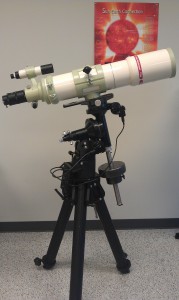 |
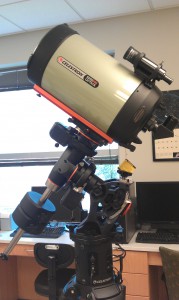 |
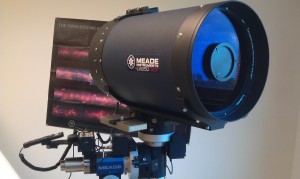 |
Three of our primary instruments are shown above: (from left to right), a Takahashi 5-inch refractor, a NexStar 11-inch Cassegrain and a Meade 14-inch LX 850 Cassegrain.
Although the five year cycle of Title III funding ended 30 September 2017, we have funding available for the observatory expansions and upgrades. The CRI / RaISE (Chancellor’s Research Initiative / Radiation Institute for Science and Engineering) has been completed and is actively doing research; the Prairie View Observatory telescope is being brought back on line. Mr. Cudnik, along with Drs. Saganti, Bentley, Erickson, and Aluka, will be re-evaluating the various activities and exercises in our inventory to explore classroom activity utilizing these Title III resources. We have already used Title-III purchased equipment to show the sun safely to 15 students of Mr. Cudnik’s Introduction to Atmospheric Science in the Spring of 2016; we also had 15 students look at the Sun during the May 9 Mercury Transit and many members of Dr. Bentley’s family enjoyed safe views of the sun back on July 15. During the most recent school year (2017-2018) we have had several solar scope viewing sessions and a few tours of the solar observatory facilities.
Our latest satellite project is the Ten Koh Charged Particle Detector, being brought to completion in preparation for launch by the Japanese space agency JAXA in August of 2018. This payload will be launched together with a second satellite called KhalifaSat, an observation satellite for the government of Dubai. Ten Koh will be part of GOSAT-2 to be launched to monitor greenhouse gas emissions from space. Ten Koh will be placed in a polar, Sun-synchronous orbit averaging 600 km altitude and will carry an array of sensors for monitoring the radiation environment. Ten Koh is a collaboration between PVAMU CRI-RaISE, NASA, Kyushu Institute of Technology, and JAXA.
Astronomy is not only a very fascinating area of science but it is also an exciting area of study for many undergraduate students around the world. Many physics departments across the nation traditionally identified as “physics and astronomy departments” and this is true for many institutions in the State of Texas as well. Technology useful for scientific quality astronomical data has become available to the masses, and universities also benefit in that they are able to establish an activity involving “real” astronomy at relatively low cost. Within the Physics Program at Prairie View A&M University, an astronomy component is being established with our current expertise in astronomy, and help from Title III funding. Our activity, “Astronomy and Astrophysics Imaging at Prairie View A&M University” promises to bring to our Physics majors and minors, as well as all of our physics and physical science students an opportunity to become involved in a rewarding activity that is “out of this world”. We have a list of potential projects that students can be involved in and have already established a “Center for Astronomical Sciences and Technologies” (CAST) laboratory in room 325 in the E.E. O’Banion (New) Science Building.
In recent years, there has been a significant increase in the numbers of physics majors at PVAMU. We have had as many as 16 physics majors including double majors. As such we need a support structure (in terms of academic excellence and research opportunities) for these majors to complete their degrees and astronomy component is a popular and a competitive aspect of this structure. In addition to serve our existing majors, implementing and increasing an astronomical presence within the program will appeal to a broader audience: education majors planning to teach science, chemistry majors looking for another application for their subject area including spectroscopic applications, visiting teachers and students (e.g. summer programs, academic year visits from Texas schools, etc.) and future physics majors. Astronomy has a certain draw to it that attracts more people to the physical sciences and we would like to use that to not only attract more people to the program, but also to provide another resource for these students to gain practical, hands-on experience in a physical science that is literally “out of this world.”
With the planned activities and upgrades, along with our present accomplishments, we are progressing to gain nationwide recognition needed for our department and students. With this proposed expansion and augmentation of astronomy component through teaching and laboratory resources we are certain to reach the pinnacle of recognition deserved for an undergraduate and minority serving institution.
Spacecraft Status Updates
There are lots of automated, robotic, unmanned spacecraft exploring various parts of the solar system, galaxy, and universe. DISCLAIMER: All are doing the exploration from within our local solar system, with the exception of Voyager 1 (and this only from a fields and particles perspective) none of our spacecraft have left the solar system.
NASA PhotoJournal Repository of Lunar and Planetary Images: http://photojournal.jpl.nasa.gov/
Lunar Reconnaissance Orbiter: http://www.nasa.gov/mission_pages/LRO/main/index.html
Lunar Atmosphere and Dust Environment Explorer (LADEE): http://www.nasa.gov/mission_pages/ladee/main/#.UtAZKdJDt8F
Curiosity Mars Rover: http://www.nasa.gov/mission_pages/msl/index.html
All Mars Missions: http://mars.jpl.nasa.gov/
Venus Express: http://www.esa.int/Our_Activities/Space_Science/Venus_Express
Akatsuki Venus Climate Orbiter (Japan): http://global.jaxa.jp/countdown/f17/index_e.html
Spectacular new pictures from Akatuski: http://www.planetary.org/blogs/guest-blogs/2018/0116-a-new-look-at-venus-with-akatsuki.html
MESSENGER at Mercury: http://www.nasa.gov/mission_pages/messenger/main/index.html
Solar Dynamics Observatory: http://sdo.gsfc.nasa.gov/
STEREO (Solar Observing Spacecraft): http://stereo.gsfc.nasa.gov/
Dawn at the dwarf planet Ceres: http://dawn.jpl.nasa.gov/
Juno at Jupiter: http://www.nasa.gov/mission_pages/juno/main/index.html
Cassini at Saturn (end of mission was 15 September 2017): http://saturn.jpl.nasa.gov/
New Horizons Pluto / Kuiper Belt Exploration: http://pluto.jhuapl.edu/
Kepler Planet-Hunter Spacecraft: https://www.nasa.gov/mission_pages/kepler/overview/index.html
GAIA (search for Earth-like worlds): http://sci.esa.int/gaia/
Hubble Space Telescope: http://hubblesite.org/
Project Status archive: (Spring 2013)
We are in the first year of a five year activity cycle and have made purchases of many pieces of state-of-the-art equipment. We will be providing images soon of some of this equipment. One of the first significant pieces of equipment is a “Solar Max” Coronado 90 mm Hydrogen-alpha solar telescope, which will enable detailed study of the activity on the sun’s disk. With a video connection and laptop, we will be able to display the sun for entire classes to see at once. Also we have the capability right now to image the Sun and bright nighttime celestial objects, one of the purposes of which is providing activities for our majors to use for their Senior Research Projects.
One project we plan to start over the summer is monitoring the moon for meteoroid impacts. More on this project will be forth coming but information on the monitoring of meteoroid impacts can be found on the web page of the Lunar Meteoroid Impact Search Section of the Association of Lunar and Planetary Observers, http://www.alpo-astronomy.org . The primary instrument for this work will be a Meade 14-inch telescope and will be used for up to 5 days twice per month, weather permitting.
Dr. Saganti is working with a colleague from NASA-Johnson Space Center, Mr. Doug Holland, to test and validate a new scientific-grade detector that uses CMOS (Complementary Metal-Oxide Semiconductor) technology. A number of images have been produced and published online at http://www.holland-observatory.net/recent/.
We are awaiting the arrival of a Meade LX 200 16-inch scope. This instrument will be for planetary and deep astronomy; one project involves the monitoring of Jupiter for meteors in its atmosphere as several have been reported with identically-sized instruments in recent years. In the meantime, software and hardware essential for these projects are being acquired and observations will be scheduled, involving students as much as possible.
Check back as this site will be updated regularly with accomplishments and activities as time passes. We hope to get our computing environment set up over spring break so as to be able to process images; some additional hardware for lunar meteor impact work will be purchased in the near term and activities in conjunction with the Astronomy and Astrophysics class that Mr. Cudnik is currently teaching will be defined and tested during the second half of the semester
We are in the first year of a five year activity cycle and have made purchases of many pieces of state-of-the-art equipment. We will be providing images soon of some of this equipment. One of the first significant pieces of equipment is a “Solar Max” Coronado 90 mm Hydrogen-alpha solar telescope, which will enable detailed study of the activity on the sun’s disk. With a video connection and laptop, we will be able to display the sun for entire classes to see at once. Also we have the capability right now to image the Sun and bright nighttime celestial objects, one of the purposes of which is providing activities for our majors to use for their Senior Research Projects.
Dr. Saganti is working with a colleague from NASA-Johnson Space Center, Mr. Doug Holland, to test and validate a new scientific-grade detector that uses CMOS (Complementary Metal-Oxide Semiconductor) technology. A number of images have been produced and published online at http://www.holland-observatory.net/recent/.
We are awaiting the arrival of two medium-sized telescopes, expected sometime around Spring Break. They include a Meade 14-inch and a Meade LX 200 16-inch scope. The former will be used for lunar meteor impact monitoring which will happen twice per month for five-day stretches, weather permitting, starting in April. The Meade LX 200 16-inch scope will be for planetary and deep astronomy; one project involves the monitoring of Jupiter for meteors in its atmosphere as several have been reported with identically-sized instruments in recent years. In the meantime, software and hardware essential for these projects are being acquired and observations will be scheduled, involving students as much as possible.
Check back as this site will be updated regularly with accomplishments and activities as time passes. We hope to get our computing environment set up over spring break so as to be able to process images; some additional hardware for lunar meteor impact work will be purchased in the near term and activities in conjunction with the Astronomy and Astrophysics class that Mr. Cudnik is currently teaching will be defined and tested during the second half of the semester.

